Portfolio - Cultural Motivation: Exercise Adherence and Behavior
VerifiedAdded on 2021/09/10
|11
|2490
|189
Portfolio
AI Summary
This portfolio delves into the crucial role of cultural motivation in influencing exercise behavior, particularly among indigenous populations. It explores the impact of cultural and socioeconomic backgrounds on physical activity, highlighting barriers such as lack of awareness, poor economic conditions, and limited access to resources. The portfolio examines the degree of motivation, confidence, and commitment required for behavior change, emphasizing self-determination and the need for knowledge integration. It identifies factors determining exercise adherence, including situational and physical factors, and provides guidelines for improving adherence through self-determination, goal setting, and in-depth health assessments. The portfolio also presents strategies for motivating exercise behavior, such as immediate outcome perception, goal setting, and the use of fitness trainers. Furthermore, it outlines a plan for changing behavior, reinforcing positive beliefs, and instructing clients through fitness sessions using motivational techniques and arousal control techniques like biofeedback. The aim is to promote health and well-being within the community by encouraging regular physical activity.
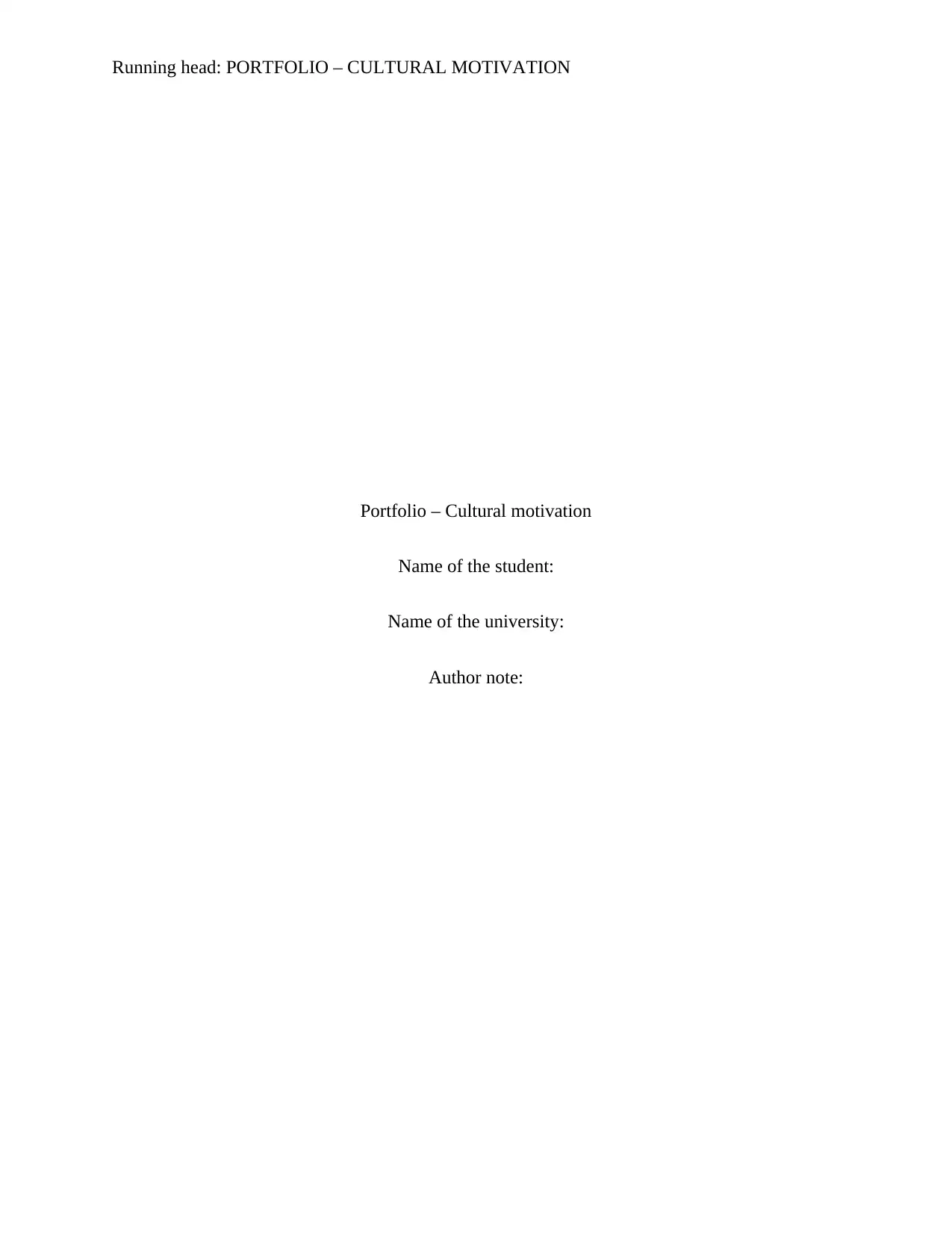
Running head: PORTFOLIO – CULTURAL MOTIVATION
Portfolio – Cultural motivation
Name of the student:
Name of the university:
Author note:
Portfolio – Cultural motivation
Name of the student:
Name of the university:
Author note:
Secure Best Marks with AI Grader
Need help grading? Try our AI Grader for instant feedback on your assignments.
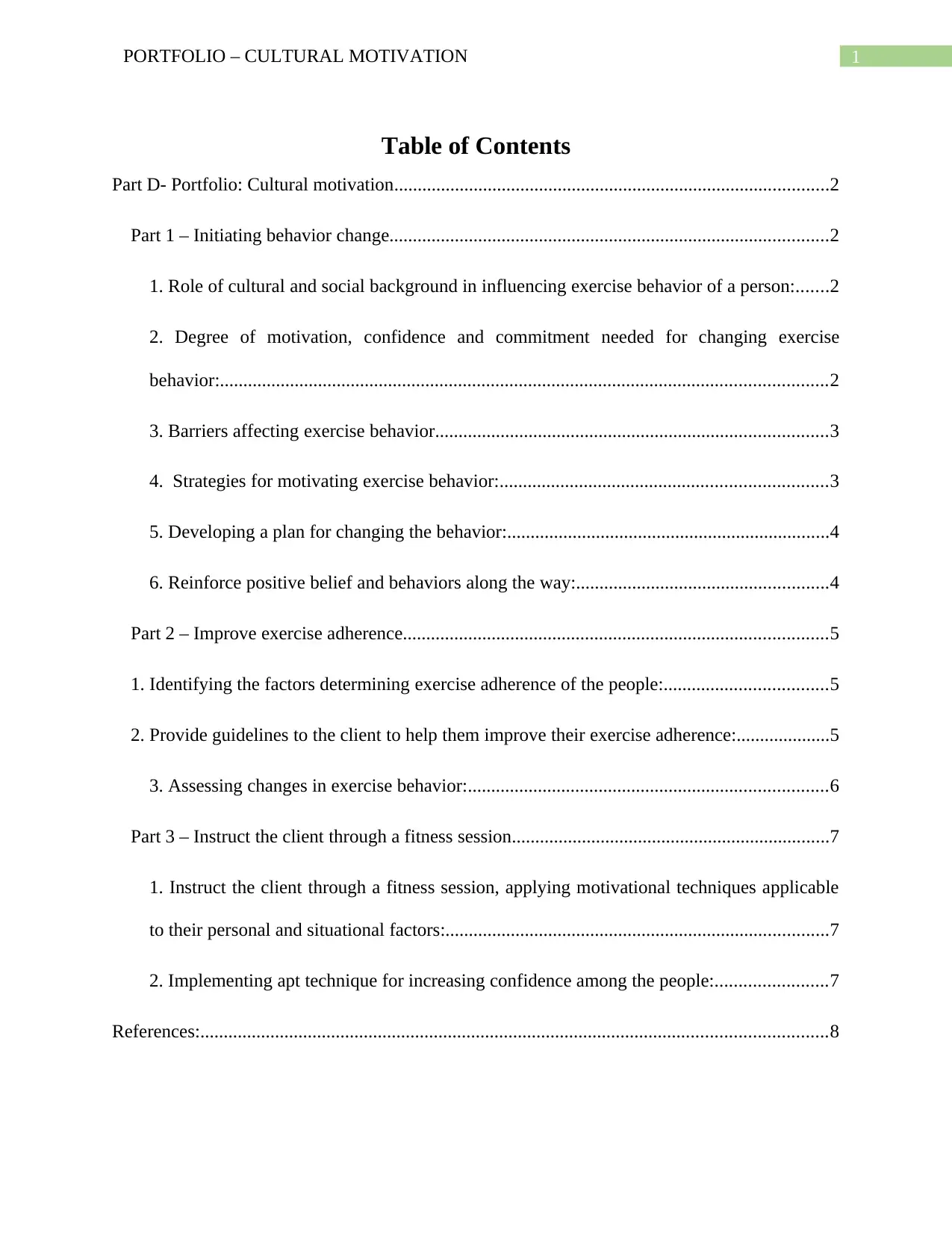
1PORTFOLIO – CULTURAL MOTIVATION
Table of Contents
Part D- Portfolio: Cultural motivation.............................................................................................2
Part 1 – Initiating behavior change..............................................................................................2
1. Role of cultural and social background in influencing exercise behavior of a person:.......2
2. Degree of motivation, confidence and commitment needed for changing exercise
behavior:..................................................................................................................................2
3. Barriers affecting exercise behavior....................................................................................3
4. Strategies for motivating exercise behavior:......................................................................3
5. Developing a plan for changing the behavior:.....................................................................4
6. Reinforce positive belief and behaviors along the way:......................................................4
Part 2 – Improve exercise adherence...........................................................................................5
1. Identifying the factors determining exercise adherence of the people:...................................5
2. Provide guidelines to the client to help them improve their exercise adherence:....................5
3. Assessing changes in exercise behavior:.............................................................................6
Part 3 – Instruct the client through a fitness session....................................................................7
1. Instruct the client through a fitness session, applying motivational techniques applicable
to their personal and situational factors:..................................................................................7
2. Implementing apt technique for increasing confidence among the people:........................7
References:......................................................................................................................................8
Table of Contents
Part D- Portfolio: Cultural motivation.............................................................................................2
Part 1 – Initiating behavior change..............................................................................................2
1. Role of cultural and social background in influencing exercise behavior of a person:.......2
2. Degree of motivation, confidence and commitment needed for changing exercise
behavior:..................................................................................................................................2
3. Barriers affecting exercise behavior....................................................................................3
4. Strategies for motivating exercise behavior:......................................................................3
5. Developing a plan for changing the behavior:.....................................................................4
6. Reinforce positive belief and behaviors along the way:......................................................4
Part 2 – Improve exercise adherence...........................................................................................5
1. Identifying the factors determining exercise adherence of the people:...................................5
2. Provide guidelines to the client to help them improve their exercise adherence:....................5
3. Assessing changes in exercise behavior:.............................................................................6
Part 3 – Instruct the client through a fitness session....................................................................7
1. Instruct the client through a fitness session, applying motivational techniques applicable
to their personal and situational factors:..................................................................................7
2. Implementing apt technique for increasing confidence among the people:........................7
References:......................................................................................................................................8

2PORTFOLIO – CULTURAL MOTIVATION
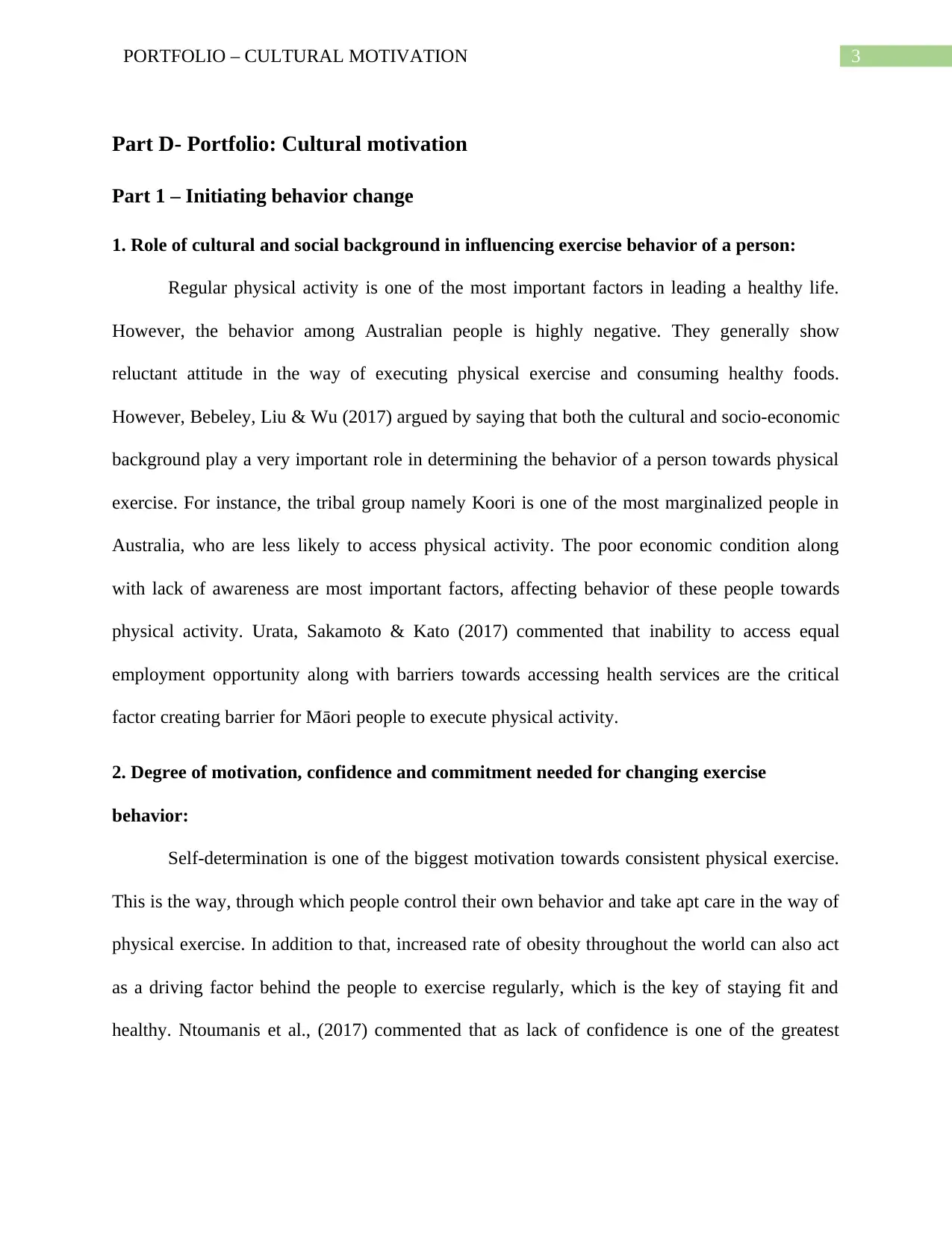
3PORTFOLIO – CULTURAL MOTIVATION
Part D- Portfolio: Cultural motivation
Part 1 – Initiating behavior change
1. Role of cultural and social background in influencing exercise behavior of a person:
Regular physical activity is one of the most important factors in leading a healthy life.
However, the behavior among Australian people is highly negative. They generally show
reluctant attitude in the way of executing physical exercise and consuming healthy foods.
However, Bebeley, Liu & Wu (2017) argued by saying that both the cultural and socio-economic
background play a very important role in determining the behavior of a person towards physical
exercise. For instance, the tribal group namely Koori is one of the most marginalized people in
Australia, who are less likely to access physical activity. The poor economic condition along
with lack of awareness are most important factors, affecting behavior of these people towards
physical activity. Urata, Sakamoto & Kato (2017) commented that inability to access equal
employment opportunity along with barriers towards accessing health services are the critical
factor creating barrier for Māori people to execute physical activity.
2. Degree of motivation, confidence and commitment needed for changing exercise
behavior:
Self-determination is one of the biggest motivation towards consistent physical exercise.
This is the way, through which people control their own behavior and take apt care in the way of
physical exercise. In addition to that, increased rate of obesity throughout the world can also act
as a driving factor behind the people to exercise regularly, which is the key of staying fit and
healthy. Ntoumanis et al., (2017) commented that as lack of confidence is one of the greatest
Part D- Portfolio: Cultural motivation
Part 1 – Initiating behavior change
1. Role of cultural and social background in influencing exercise behavior of a person:
Regular physical activity is one of the most important factors in leading a healthy life.
However, the behavior among Australian people is highly negative. They generally show
reluctant attitude in the way of executing physical exercise and consuming healthy foods.
However, Bebeley, Liu & Wu (2017) argued by saying that both the cultural and socio-economic
background play a very important role in determining the behavior of a person towards physical
exercise. For instance, the tribal group namely Koori is one of the most marginalized people in
Australia, who are less likely to access physical activity. The poor economic condition along
with lack of awareness are most important factors, affecting behavior of these people towards
physical activity. Urata, Sakamoto & Kato (2017) commented that inability to access equal
employment opportunity along with barriers towards accessing health services are the critical
factor creating barrier for Māori people to execute physical activity.
2. Degree of motivation, confidence and commitment needed for changing exercise
behavior:
Self-determination is one of the biggest motivation towards consistent physical exercise.
This is the way, through which people control their own behavior and take apt care in the way of
physical exercise. In addition to that, increased rate of obesity throughout the world can also act
as a driving factor behind the people to exercise regularly, which is the key of staying fit and
healthy. Ntoumanis et al., (2017) commented that as lack of confidence is one of the greatest
Secure Best Marks with AI Grader
Need help grading? Try our AI Grader for instant feedback on your assignments.
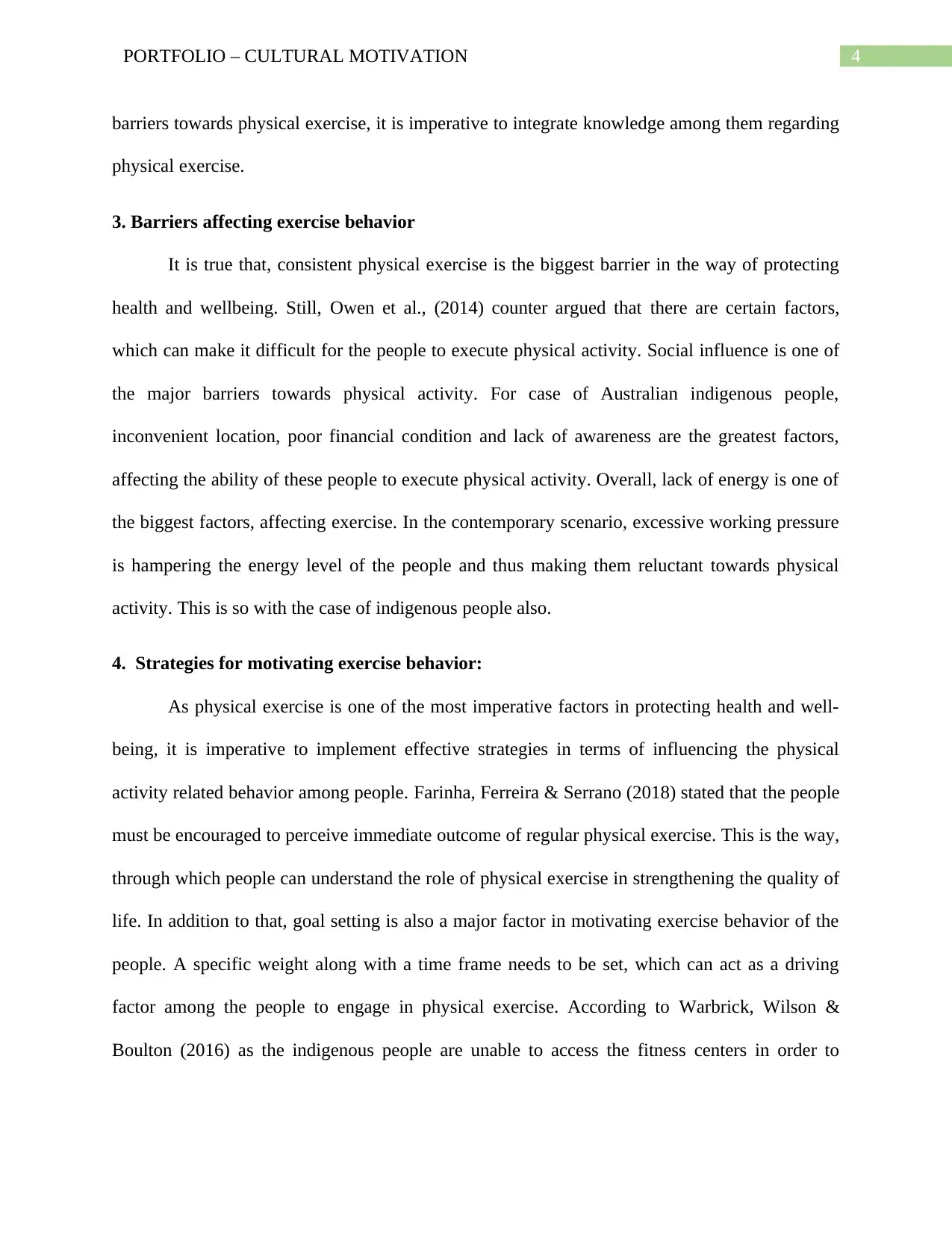
4PORTFOLIO – CULTURAL MOTIVATION
barriers towards physical exercise, it is imperative to integrate knowledge among them regarding
physical exercise.
3. Barriers affecting exercise behavior
It is true that, consistent physical exercise is the biggest barrier in the way of protecting
health and wellbeing. Still, Owen et al., (2014) counter argued that there are certain factors,
which can make it difficult for the people to execute physical activity. Social influence is one of
the major barriers towards physical activity. For case of Australian indigenous people,
inconvenient location, poor financial condition and lack of awareness are the greatest factors,
affecting the ability of these people to execute physical activity. Overall, lack of energy is one of
the biggest factors, affecting exercise. In the contemporary scenario, excessive working pressure
is hampering the energy level of the people and thus making them reluctant towards physical
activity. This is so with the case of indigenous people also.
4. Strategies for motivating exercise behavior:
As physical exercise is one of the most imperative factors in protecting health and well-
being, it is imperative to implement effective strategies in terms of influencing the physical
activity related behavior among people. Farinha, Ferreira & Serrano (2018) stated that the people
must be encouraged to perceive immediate outcome of regular physical exercise. This is the way,
through which people can understand the role of physical exercise in strengthening the quality of
life. In addition to that, goal setting is also a major factor in motivating exercise behavior of the
people. A specific weight along with a time frame needs to be set, which can act as a driving
factor among the people to engage in physical exercise. According to Warbrick, Wilson &
Boulton (2016) as the indigenous people are unable to access the fitness centers in order to
barriers towards physical exercise, it is imperative to integrate knowledge among them regarding
physical exercise.
3. Barriers affecting exercise behavior
It is true that, consistent physical exercise is the biggest barrier in the way of protecting
health and wellbeing. Still, Owen et al., (2014) counter argued that there are certain factors,
which can make it difficult for the people to execute physical activity. Social influence is one of
the major barriers towards physical activity. For case of Australian indigenous people,
inconvenient location, poor financial condition and lack of awareness are the greatest factors,
affecting the ability of these people to execute physical activity. Overall, lack of energy is one of
the biggest factors, affecting exercise. In the contemporary scenario, excessive working pressure
is hampering the energy level of the people and thus making them reluctant towards physical
activity. This is so with the case of indigenous people also.
4. Strategies for motivating exercise behavior:
As physical exercise is one of the most imperative factors in protecting health and well-
being, it is imperative to implement effective strategies in terms of influencing the physical
activity related behavior among people. Farinha, Ferreira & Serrano (2018) stated that the people
must be encouraged to perceive immediate outcome of regular physical exercise. This is the way,
through which people can understand the role of physical exercise in strengthening the quality of
life. In addition to that, goal setting is also a major factor in motivating exercise behavior of the
people. A specific weight along with a time frame needs to be set, which can act as a driving
factor among the people to engage in physical exercise. According to Warbrick, Wilson &
Boulton (2016) as the indigenous people are unable to access the fitness centers in order to
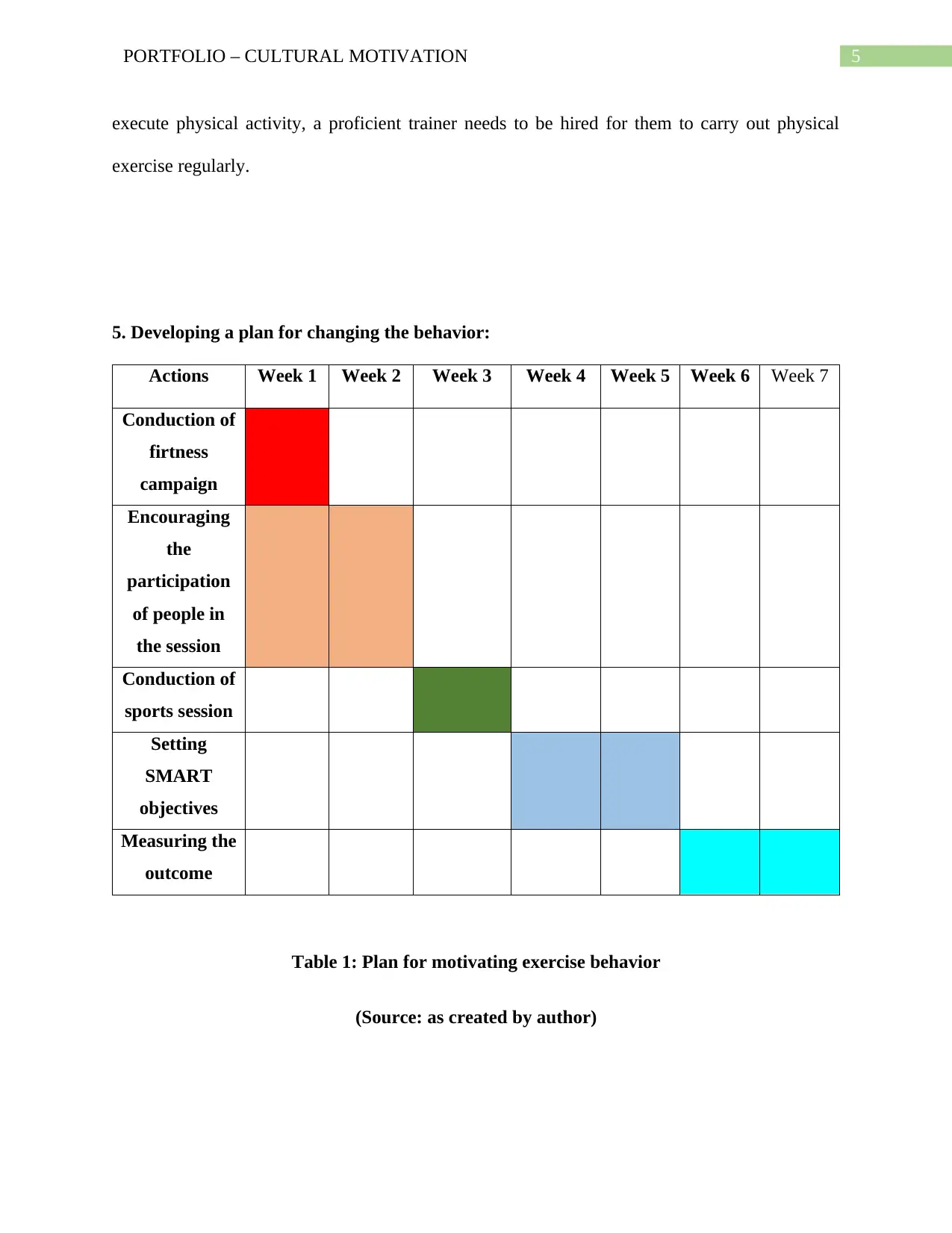
5PORTFOLIO – CULTURAL MOTIVATION
execute physical activity, a proficient trainer needs to be hired for them to carry out physical
exercise regularly.
5. Developing a plan for changing the behavior:
Actions Week 1 Week 2 Week 3 Week 4 Week 5 Week 6 Week 7
Conduction of
firtness
campaign
Encouraging
the
participation
of people in
the session
Conduction of
sports session
Setting
SMART
objectives
Measuring the
outcome
Table 1: Plan for motivating exercise behavior
(Source: as created by author)
execute physical activity, a proficient trainer needs to be hired for them to carry out physical
exercise regularly.
5. Developing a plan for changing the behavior:
Actions Week 1 Week 2 Week 3 Week 4 Week 5 Week 6 Week 7
Conduction of
firtness
campaign
Encouraging
the
participation
of people in
the session
Conduction of
sports session
Setting
SMART
objectives
Measuring the
outcome
Table 1: Plan for motivating exercise behavior
(Source: as created by author)
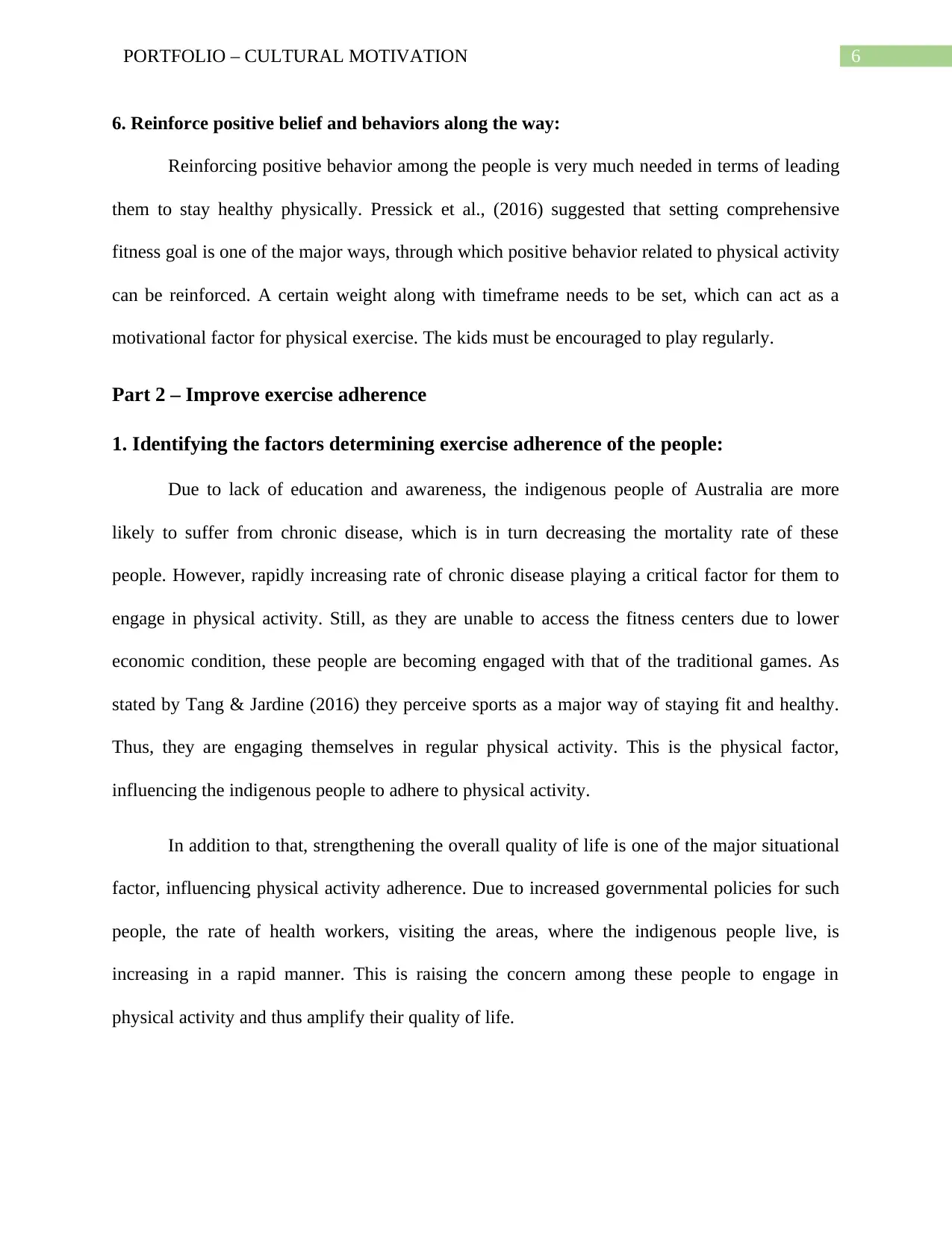
6PORTFOLIO – CULTURAL MOTIVATION
6. Reinforce positive belief and behaviors along the way:
Reinforcing positive behavior among the people is very much needed in terms of leading
them to stay healthy physically. Pressick et al., (2016) suggested that setting comprehensive
fitness goal is one of the major ways, through which positive behavior related to physical activity
can be reinforced. A certain weight along with timeframe needs to be set, which can act as a
motivational factor for physical exercise. The kids must be encouraged to play regularly.
Part 2 – Improve exercise adherence
1. Identifying the factors determining exercise adherence of the people:
Due to lack of education and awareness, the indigenous people of Australia are more
likely to suffer from chronic disease, which is in turn decreasing the mortality rate of these
people. However, rapidly increasing rate of chronic disease playing a critical factor for them to
engage in physical activity. Still, as they are unable to access the fitness centers due to lower
economic condition, these people are becoming engaged with that of the traditional games. As
stated by Tang & Jardine (2016) they perceive sports as a major way of staying fit and healthy.
Thus, they are engaging themselves in regular physical activity. This is the physical factor,
influencing the indigenous people to adhere to physical activity.
In addition to that, strengthening the overall quality of life is one of the major situational
factor, influencing physical activity adherence. Due to increased governmental policies for such
people, the rate of health workers, visiting the areas, where the indigenous people live, is
increasing in a rapid manner. This is raising the concern among these people to engage in
physical activity and thus amplify their quality of life.
6. Reinforce positive belief and behaviors along the way:
Reinforcing positive behavior among the people is very much needed in terms of leading
them to stay healthy physically. Pressick et al., (2016) suggested that setting comprehensive
fitness goal is one of the major ways, through which positive behavior related to physical activity
can be reinforced. A certain weight along with timeframe needs to be set, which can act as a
motivational factor for physical exercise. The kids must be encouraged to play regularly.
Part 2 – Improve exercise adherence
1. Identifying the factors determining exercise adherence of the people:
Due to lack of education and awareness, the indigenous people of Australia are more
likely to suffer from chronic disease, which is in turn decreasing the mortality rate of these
people. However, rapidly increasing rate of chronic disease playing a critical factor for them to
engage in physical activity. Still, as they are unable to access the fitness centers due to lower
economic condition, these people are becoming engaged with that of the traditional games. As
stated by Tang & Jardine (2016) they perceive sports as a major way of staying fit and healthy.
Thus, they are engaging themselves in regular physical activity. This is the physical factor,
influencing the indigenous people to adhere to physical activity.
In addition to that, strengthening the overall quality of life is one of the major situational
factor, influencing physical activity adherence. Due to increased governmental policies for such
people, the rate of health workers, visiting the areas, where the indigenous people live, is
increasing in a rapid manner. This is raising the concern among these people to engage in
physical activity and thus amplify their quality of life.
Paraphrase This Document
Need a fresh take? Get an instant paraphrase of this document with our AI Paraphraser
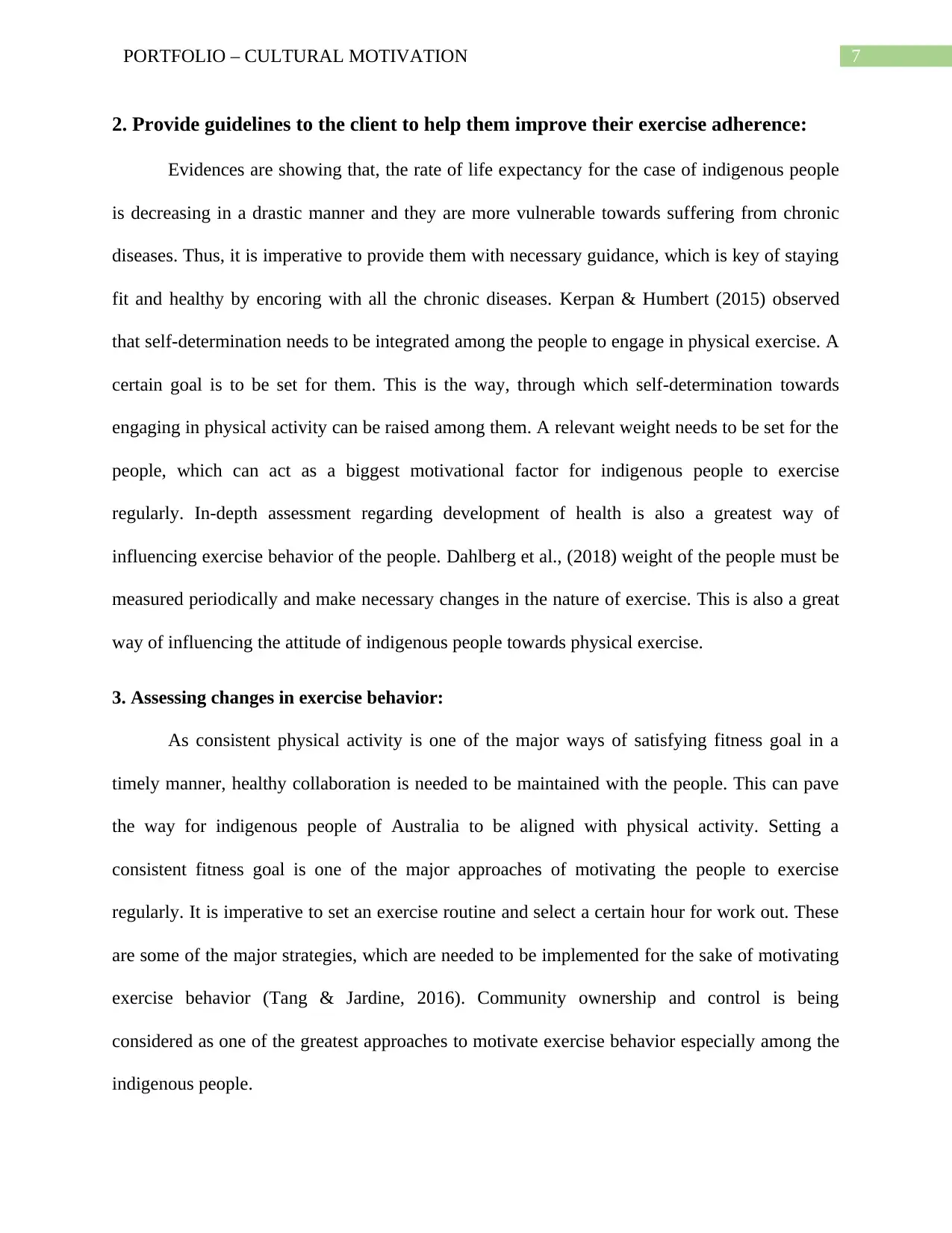
7PORTFOLIO – CULTURAL MOTIVATION
2. Provide guidelines to the client to help them improve their exercise adherence:
Evidences are showing that, the rate of life expectancy for the case of indigenous people
is decreasing in a drastic manner and they are more vulnerable towards suffering from chronic
diseases. Thus, it is imperative to provide them with necessary guidance, which is key of staying
fit and healthy by encoring with all the chronic diseases. Kerpan & Humbert (2015) observed
that self-determination needs to be integrated among the people to engage in physical exercise. A
certain goal is to be set for them. This is the way, through which self-determination towards
engaging in physical activity can be raised among them. A relevant weight needs to be set for the
people, which can act as a biggest motivational factor for indigenous people to exercise
regularly. In-depth assessment regarding development of health is also a greatest way of
influencing exercise behavior of the people. Dahlberg et al., (2018) weight of the people must be
measured periodically and make necessary changes in the nature of exercise. This is also a great
way of influencing the attitude of indigenous people towards physical exercise.
3. Assessing changes in exercise behavior:
As consistent physical activity is one of the major ways of satisfying fitness goal in a
timely manner, healthy collaboration is needed to be maintained with the people. This can pave
the way for indigenous people of Australia to be aligned with physical activity. Setting a
consistent fitness goal is one of the major approaches of motivating the people to exercise
regularly. It is imperative to set an exercise routine and select a certain hour for work out. These
are some of the major strategies, which are needed to be implemented for the sake of motivating
exercise behavior (Tang & Jardine, 2016). Community ownership and control is being
considered as one of the greatest approaches to motivate exercise behavior especially among the
indigenous people.
2. Provide guidelines to the client to help them improve their exercise adherence:
Evidences are showing that, the rate of life expectancy for the case of indigenous people
is decreasing in a drastic manner and they are more vulnerable towards suffering from chronic
diseases. Thus, it is imperative to provide them with necessary guidance, which is key of staying
fit and healthy by encoring with all the chronic diseases. Kerpan & Humbert (2015) observed
that self-determination needs to be integrated among the people to engage in physical exercise. A
certain goal is to be set for them. This is the way, through which self-determination towards
engaging in physical activity can be raised among them. A relevant weight needs to be set for the
people, which can act as a biggest motivational factor for indigenous people to exercise
regularly. In-depth assessment regarding development of health is also a greatest way of
influencing exercise behavior of the people. Dahlberg et al., (2018) weight of the people must be
measured periodically and make necessary changes in the nature of exercise. This is also a great
way of influencing the attitude of indigenous people towards physical exercise.
3. Assessing changes in exercise behavior:
As consistent physical activity is one of the major ways of satisfying fitness goal in a
timely manner, healthy collaboration is needed to be maintained with the people. This can pave
the way for indigenous people of Australia to be aligned with physical activity. Setting a
consistent fitness goal is one of the major approaches of motivating the people to exercise
regularly. It is imperative to set an exercise routine and select a certain hour for work out. These
are some of the major strategies, which are needed to be implemented for the sake of motivating
exercise behavior (Tang & Jardine, 2016). Community ownership and control is being
considered as one of the greatest approaches to motivate exercise behavior especially among the
indigenous people.
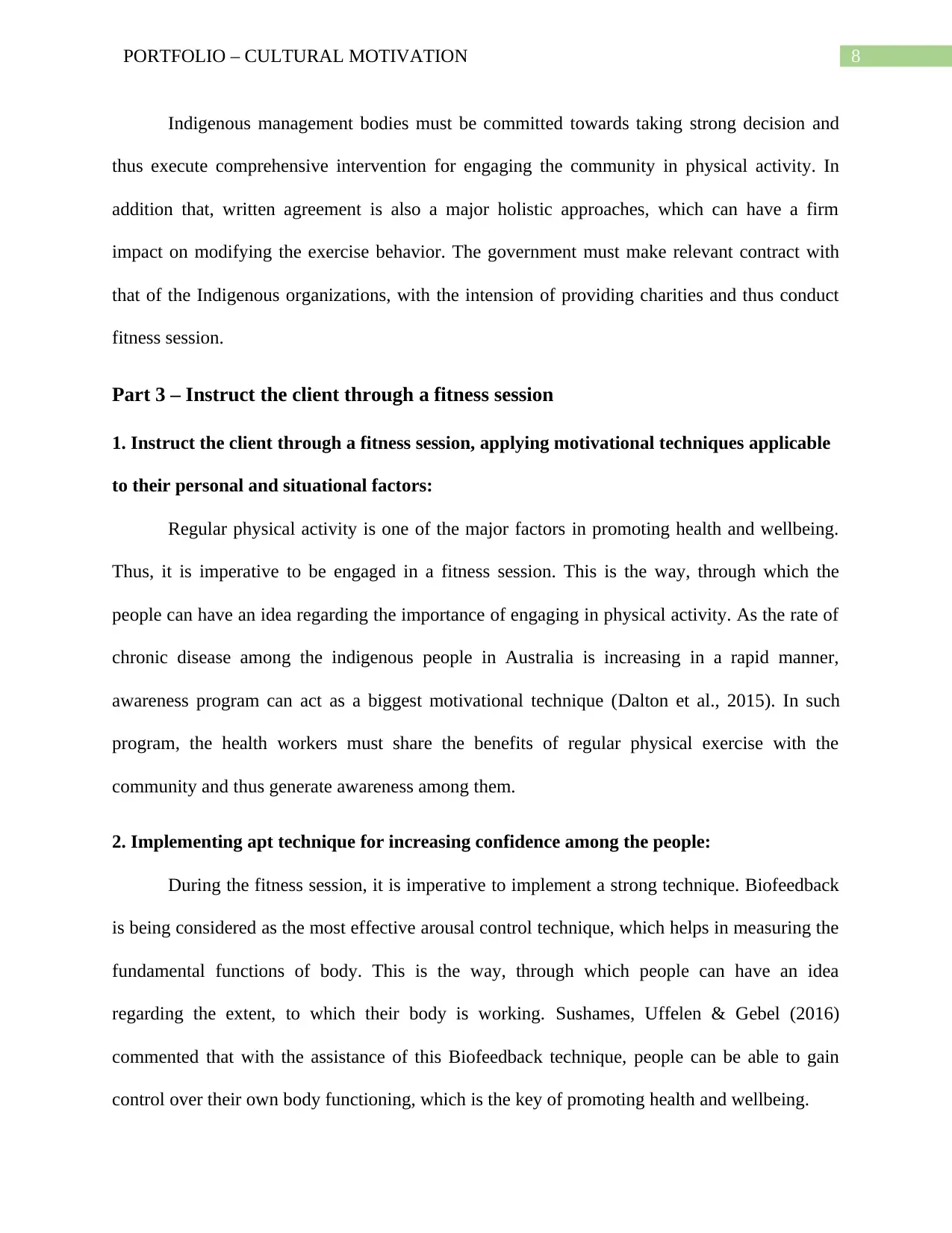
8PORTFOLIO – CULTURAL MOTIVATION
Indigenous management bodies must be committed towards taking strong decision and
thus execute comprehensive intervention for engaging the community in physical activity. In
addition that, written agreement is also a major holistic approaches, which can have a firm
impact on modifying the exercise behavior. The government must make relevant contract with
that of the Indigenous organizations, with the intension of providing charities and thus conduct
fitness session.
Part 3 – Instruct the client through a fitness session
1. Instruct the client through a fitness session, applying motivational techniques applicable
to their personal and situational factors:
Regular physical activity is one of the major factors in promoting health and wellbeing.
Thus, it is imperative to be engaged in a fitness session. This is the way, through which the
people can have an idea regarding the importance of engaging in physical activity. As the rate of
chronic disease among the indigenous people in Australia is increasing in a rapid manner,
awareness program can act as a biggest motivational technique (Dalton et al., 2015). In such
program, the health workers must share the benefits of regular physical exercise with the
community and thus generate awareness among them.
2. Implementing apt technique for increasing confidence among the people:
During the fitness session, it is imperative to implement a strong technique. Biofeedback
is being considered as the most effective arousal control technique, which helps in measuring the
fundamental functions of body. This is the way, through which people can have an idea
regarding the extent, to which their body is working. Sushames, Uffelen & Gebel (2016)
commented that with the assistance of this Biofeedback technique, people can be able to gain
control over their own body functioning, which is the key of promoting health and wellbeing.
Indigenous management bodies must be committed towards taking strong decision and
thus execute comprehensive intervention for engaging the community in physical activity. In
addition that, written agreement is also a major holistic approaches, which can have a firm
impact on modifying the exercise behavior. The government must make relevant contract with
that of the Indigenous organizations, with the intension of providing charities and thus conduct
fitness session.
Part 3 – Instruct the client through a fitness session
1. Instruct the client through a fitness session, applying motivational techniques applicable
to their personal and situational factors:
Regular physical activity is one of the major factors in promoting health and wellbeing.
Thus, it is imperative to be engaged in a fitness session. This is the way, through which the
people can have an idea regarding the importance of engaging in physical activity. As the rate of
chronic disease among the indigenous people in Australia is increasing in a rapid manner,
awareness program can act as a biggest motivational technique (Dalton et al., 2015). In such
program, the health workers must share the benefits of regular physical exercise with the
community and thus generate awareness among them.
2. Implementing apt technique for increasing confidence among the people:
During the fitness session, it is imperative to implement a strong technique. Biofeedback
is being considered as the most effective arousal control technique, which helps in measuring the
fundamental functions of body. This is the way, through which people can have an idea
regarding the extent, to which their body is working. Sushames, Uffelen & Gebel (2016)
commented that with the assistance of this Biofeedback technique, people can be able to gain
control over their own body functioning, which is the key of promoting health and wellbeing.
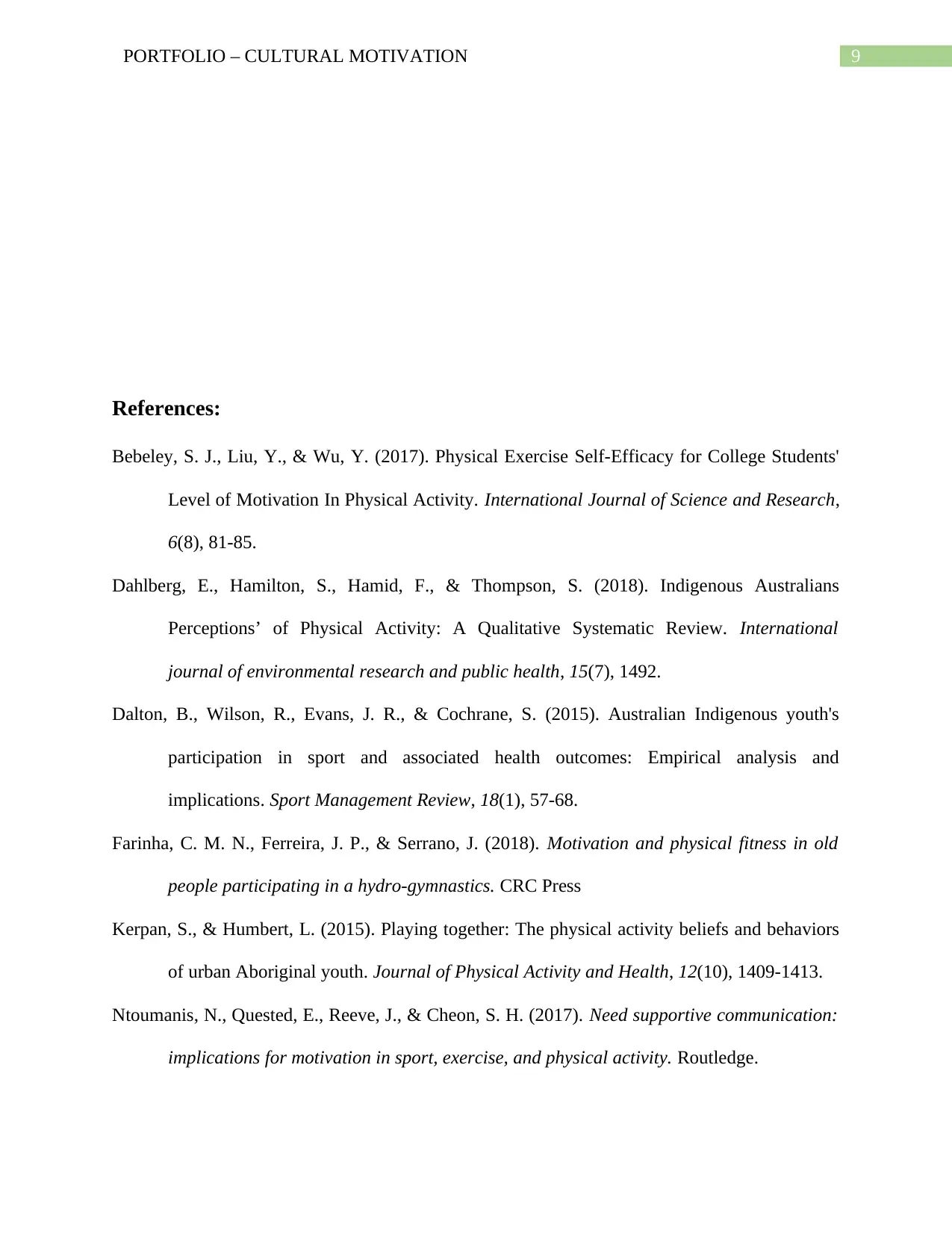
9PORTFOLIO – CULTURAL MOTIVATION
References:
Bebeley, S. J., Liu, Y., & Wu, Y. (2017). Physical Exercise Self-Efficacy for College Students'
Level of Motivation In Physical Activity. International Journal of Science and Research,
6(8), 81-85.
Dahlberg, E., Hamilton, S., Hamid, F., & Thompson, S. (2018). Indigenous Australians
Perceptions’ of Physical Activity: A Qualitative Systematic Review. International
journal of environmental research and public health, 15(7), 1492.
Dalton, B., Wilson, R., Evans, J. R., & Cochrane, S. (2015). Australian Indigenous youth's
participation in sport and associated health outcomes: Empirical analysis and
implications. Sport Management Review, 18(1), 57-68.
Farinha, C. M. N., Ferreira, J. P., & Serrano, J. (2018). Motivation and physical fitness in old
people participating in a hydro-gymnastics. CRC Press
Kerpan, S., & Humbert, L. (2015). Playing together: The physical activity beliefs and behaviors
of urban Aboriginal youth. Journal of Physical Activity and Health, 12(10), 1409-1413.
Ntoumanis, N., Quested, E., Reeve, J., & Cheon, S. H. (2017). Need supportive communication:
implications for motivation in sport, exercise, and physical activity. Routledge.
References:
Bebeley, S. J., Liu, Y., & Wu, Y. (2017). Physical Exercise Self-Efficacy for College Students'
Level of Motivation In Physical Activity. International Journal of Science and Research,
6(8), 81-85.
Dahlberg, E., Hamilton, S., Hamid, F., & Thompson, S. (2018). Indigenous Australians
Perceptions’ of Physical Activity: A Qualitative Systematic Review. International
journal of environmental research and public health, 15(7), 1492.
Dalton, B., Wilson, R., Evans, J. R., & Cochrane, S. (2015). Australian Indigenous youth's
participation in sport and associated health outcomes: Empirical analysis and
implications. Sport Management Review, 18(1), 57-68.
Farinha, C. M. N., Ferreira, J. P., & Serrano, J. (2018). Motivation and physical fitness in old
people participating in a hydro-gymnastics. CRC Press
Kerpan, S., & Humbert, L. (2015). Playing together: The physical activity beliefs and behaviors
of urban Aboriginal youth. Journal of Physical Activity and Health, 12(10), 1409-1413.
Ntoumanis, N., Quested, E., Reeve, J., & Cheon, S. H. (2017). Need supportive communication:
implications for motivation in sport, exercise, and physical activity. Routledge.
Secure Best Marks with AI Grader
Need help grading? Try our AI Grader for instant feedback on your assignments.
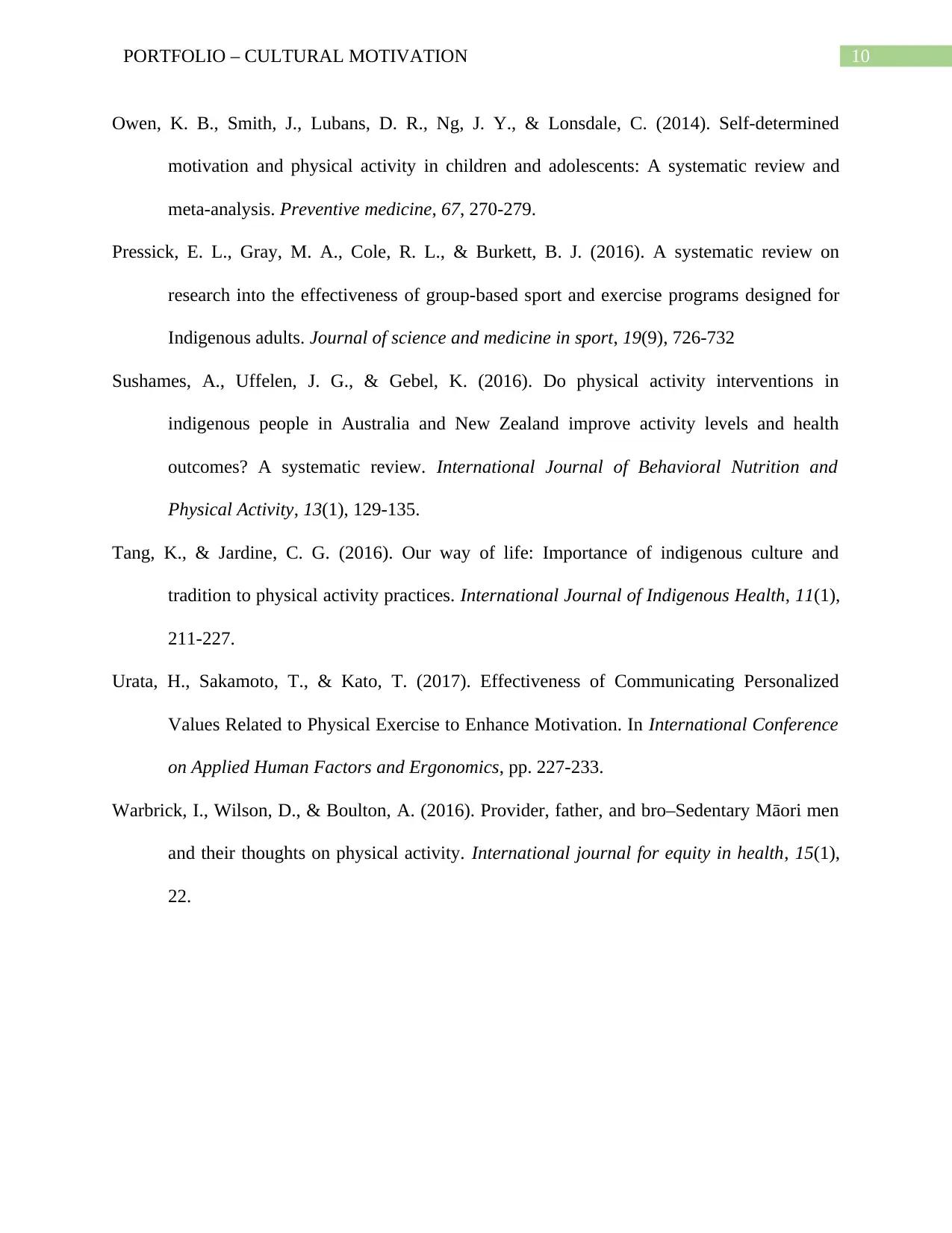
10PORTFOLIO – CULTURAL MOTIVATION
Owen, K. B., Smith, J., Lubans, D. R., Ng, J. Y., & Lonsdale, C. (2014). Self-determined
motivation and physical activity in children and adolescents: A systematic review and
meta-analysis. Preventive medicine, 67, 270-279.
Pressick, E. L., Gray, M. A., Cole, R. L., & Burkett, B. J. (2016). A systematic review on
research into the effectiveness of group-based sport and exercise programs designed for
Indigenous adults. Journal of science and medicine in sport, 19(9), 726-732
Sushames, A., Uffelen, J. G., & Gebel, K. (2016). Do physical activity interventions in
indigenous people in Australia and New Zealand improve activity levels and health
outcomes? A systematic review. International Journal of Behavioral Nutrition and
Physical Activity, 13(1), 129-135.
Tang, K., & Jardine, C. G. (2016). Our way of life: Importance of indigenous culture and
tradition to physical activity practices. International Journal of Indigenous Health, 11(1),
211-227.
Urata, H., Sakamoto, T., & Kato, T. (2017). Effectiveness of Communicating Personalized
Values Related to Physical Exercise to Enhance Motivation. In International Conference
on Applied Human Factors and Ergonomics, pp. 227-233.
Warbrick, I., Wilson, D., & Boulton, A. (2016). Provider, father, and bro–Sedentary Māori men
and their thoughts on physical activity. International journal for equity in health, 15(1),
22.
Owen, K. B., Smith, J., Lubans, D. R., Ng, J. Y., & Lonsdale, C. (2014). Self-determined
motivation and physical activity in children and adolescents: A systematic review and
meta-analysis. Preventive medicine, 67, 270-279.
Pressick, E. L., Gray, M. A., Cole, R. L., & Burkett, B. J. (2016). A systematic review on
research into the effectiveness of group-based sport and exercise programs designed for
Indigenous adults. Journal of science and medicine in sport, 19(9), 726-732
Sushames, A., Uffelen, J. G., & Gebel, K. (2016). Do physical activity interventions in
indigenous people in Australia and New Zealand improve activity levels and health
outcomes? A systematic review. International Journal of Behavioral Nutrition and
Physical Activity, 13(1), 129-135.
Tang, K., & Jardine, C. G. (2016). Our way of life: Importance of indigenous culture and
tradition to physical activity practices. International Journal of Indigenous Health, 11(1),
211-227.
Urata, H., Sakamoto, T., & Kato, T. (2017). Effectiveness of Communicating Personalized
Values Related to Physical Exercise to Enhance Motivation. In International Conference
on Applied Human Factors and Ergonomics, pp. 227-233.
Warbrick, I., Wilson, D., & Boulton, A. (2016). Provider, father, and bro–Sedentary Māori men
and their thoughts on physical activity. International journal for equity in health, 15(1),
22.
1 out of 11
Related Documents
Your All-in-One AI-Powered Toolkit for Academic Success.
+13062052269
info@desklib.com
Available 24*7 on WhatsApp / Email
![[object Object]](/_next/static/media/star-bottom.7253800d.svg)
Unlock your academic potential
© 2024 | Zucol Services PVT LTD | All rights reserved.





